A couple of Things
Welcome to a new week, everyone.
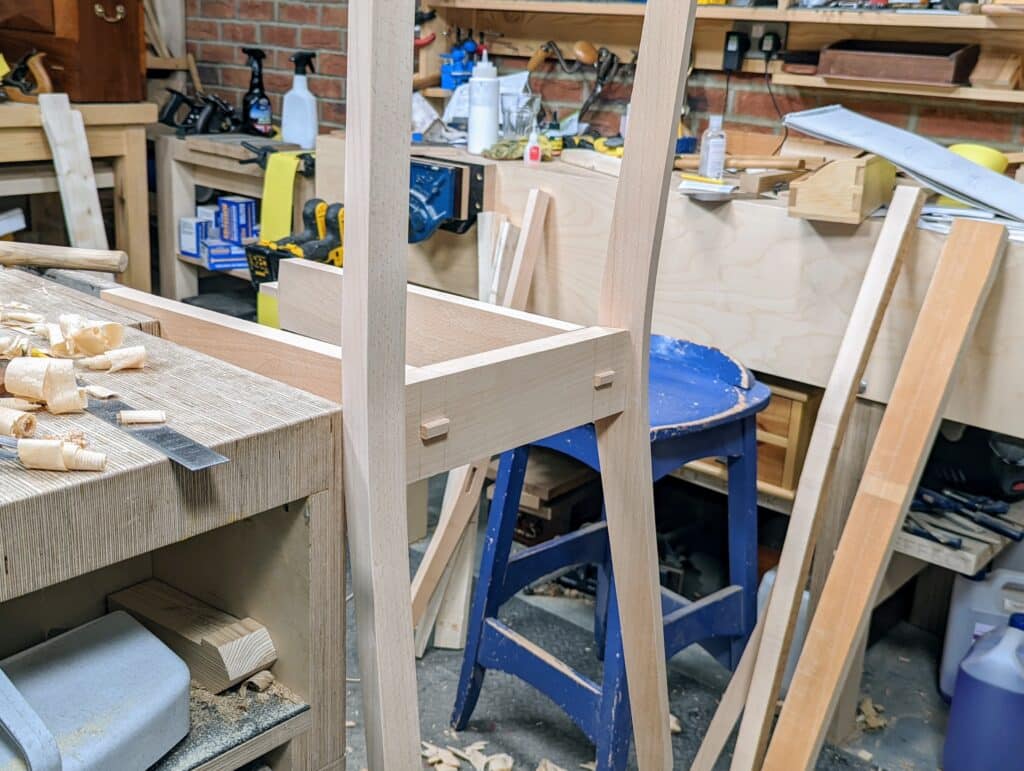
I am not sure if I have hand planed quite so many pieces in a single week for a project series as I did this week. I admit that this to some seems a waste of my time when I could use power equipment (if I had it and I am glad I don’t) and some do indeed criticise my projecting that hand tools work so well, but time restrictions curtail those working in the so-called “professional realms” in “the real world” and so on. I accept that machining wood is better for those earning their living from selling carpentry and some joinery, but then there are those of us who hate gyms, running on concrete sidewalks and then simply the boredom of exercise seems all the worse for wasting the time we can spend doing woodworking and at the same time getting our exercise by good, physical work. I am grateful that I can do both in my own specially devised ‘gymnasium‘ where bench presses have a completely different meaning and comprise clamps and vises, squats and much more using the weight of a balk of wood or straining at sawing and planing in consistent measure and such throughout any given day. Upper body exercise here builds only usable muscle and without excess, keeps the joints supple and working and, of course, the heart and lungs are pumping incessantly, often at speeds I cannot muster the same levels of enthusiasm for that I get from making something that will be both functional, useful and beautiful beyond a few bulging glutes and big guns.
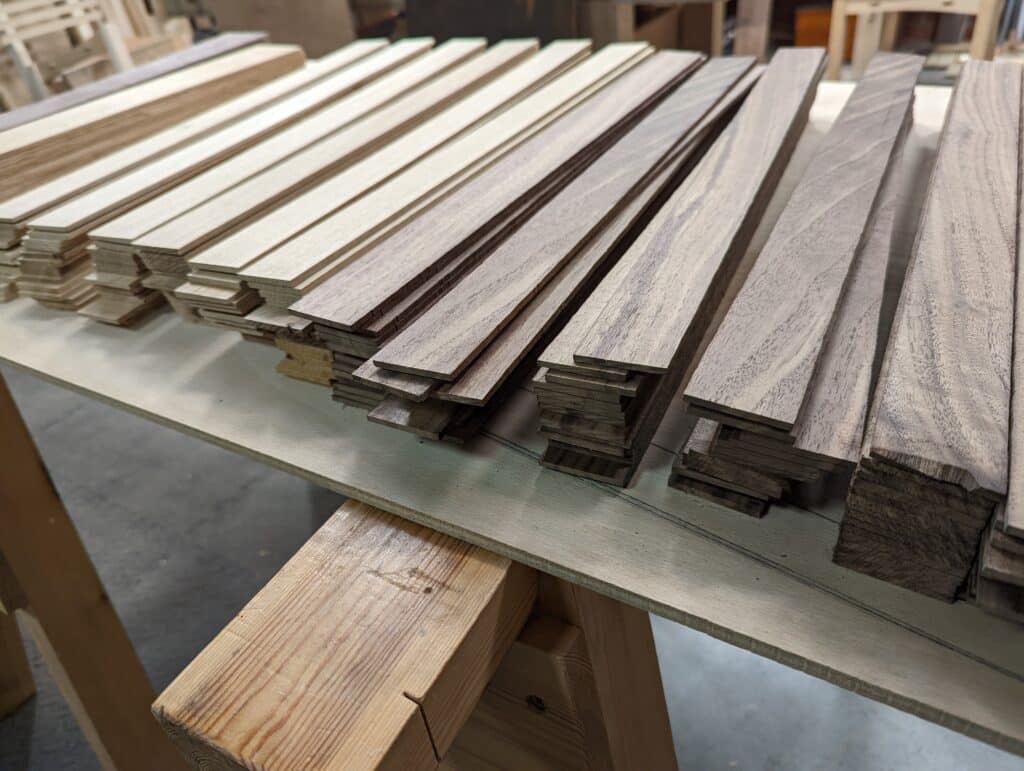
128 pieces and various section sizes of wood go into each of the eight chairs I am currently working on. I was amazed that my plane edges hold up so well planing both oak and walnut. 95% of my planing follows my strategy going from scrub #78 to scrub#4 to #5 1/2 and occasionally my low-angle Veritas Jack plane where I have added a steeper-than-usual bevel to the front of the bevel at the leading edge of the bevel-up plane iron. This is to deal with some of the ultra awkward grain in the walnut figuring I didn’t expect from outside appearance so came as a bonus. I mention this Veritas plane because of its superb blade alignment features that keep the blade aligned along its long axis of the sole and the registration of the depth adjustment which is amazing even after removing and sharpening. When I reload the blade there is barely any discrepancy between what I had previously registered for depth and alignment and reloading.
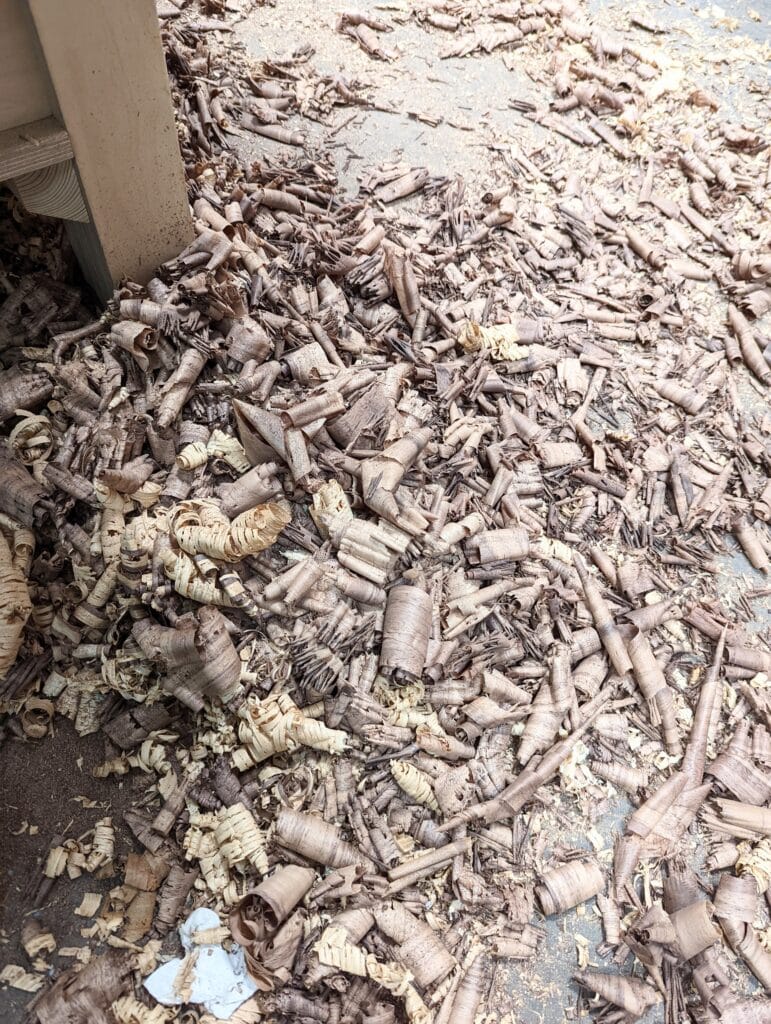
I have filled six 100 litre bags with hand-planed shavings this far in the chair project. This workout alone leaves me feeling fit and happily healthy at the end of the day. This morning I planed up the last few sticks of wood for the batch of chairs. Now I am not pretending this was easy work but I would not swap it for using a power planer or a gym for anything. Why? Well, at 72 years of age I feel about the same health-wise as I did at 45 although I did always have a machine shop too. Had I not chosen this path I believe my health would be like many of my age and much much younger who are not in good shape at all. Most woodworkers these days will not realise that although we had machines of every type and size as an apprentice, we always hand planed and scraper-finished every surface of every stick and stem before, during and after joinery. I don’t think that I have ever seen that written down. Handwork in high-demand craftwork like mine thus far has proven to be the very finest exercise I can imagine. It is evenly distributed throughout my life and throughout my days of woodworking now and it makes me feel unreasonably happy still.
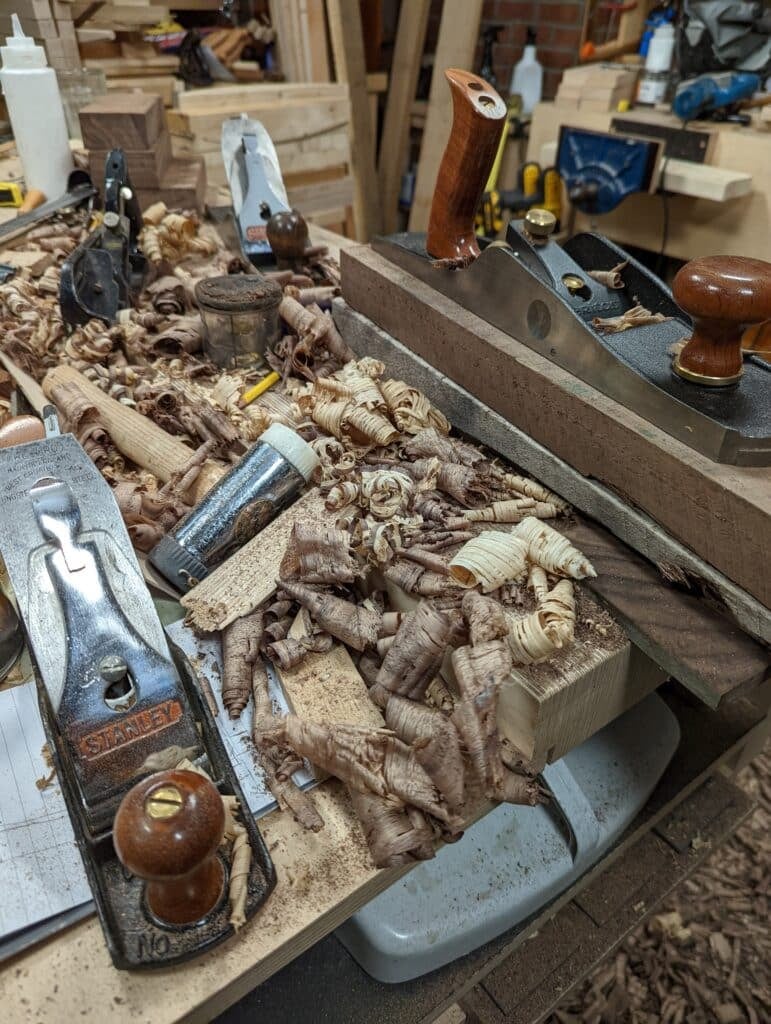
So there you have the first two things I find of great value — the quality of healthy exercise in the way of my working and the use of the additional plane by Veritas, a plane I have owned and used for 15 years. Yes, to some these are both luxury items and perhaps I could do without both. Hmm! I wouldn’t though.
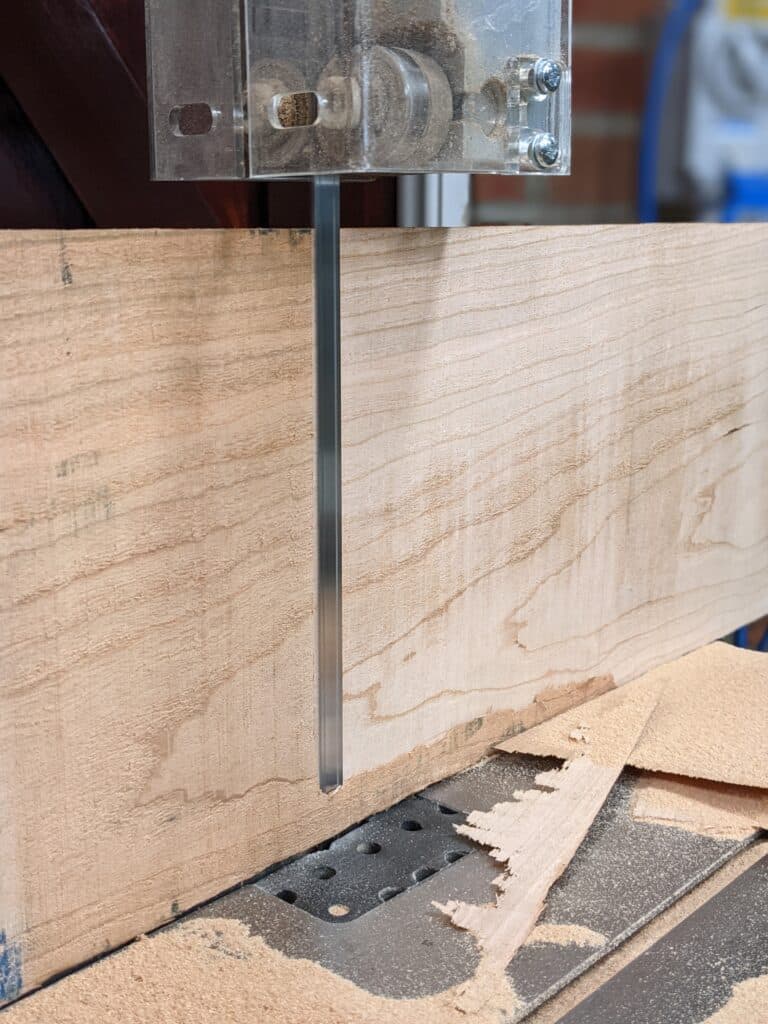
What next? Well, I do enjoy owning my lone machine which is my bandsaw. I use it for every kind of resawing and shaping and currently, with eight or so chairs underway all at once, and replete with arching, shaped back legs with tapers, etc and many a dozen linear feet to be ripped per chair, there is a lot of ripping to be done and all with heavy cuts to boot. Anyway, I have two, one for me alone to use in my garage workshop and another in the general shop where I mentor the three emerging woodworkers that work alongside me, Hannah, John and Jack. I couldn’t really spend so much time resizing my wood by hand and do all that I have to do in a day. I mean we’re talking over 700 cuts 1 1/2″ to 3″ thick with a handsaw for this series of chairs. Not too practical. But, additionally, these three need their wood sizing and so on too. Hannah is currently working on a commission for a dining table, jack is honing his skills making a couple of wall-hung spice racks and John has several pieces on the go all at once. He has been using some teak he redeployed from a vintage desk so he has made a couple of nice boxes for small tools, etc.
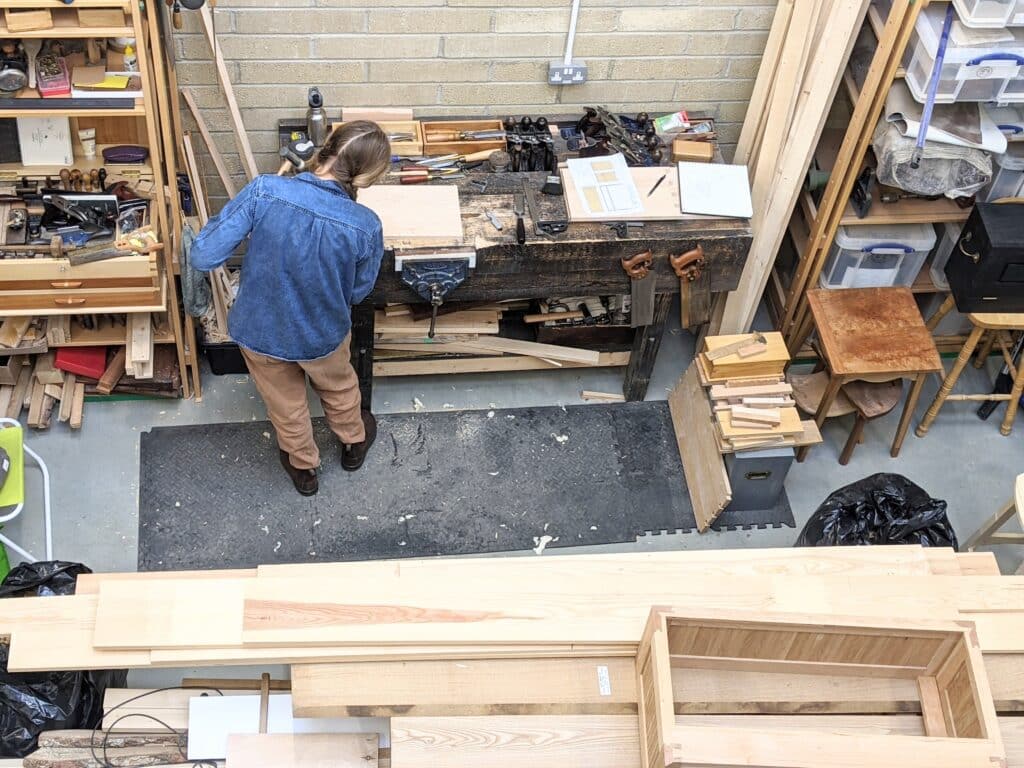
My bandsaw kerf removes just under 1/16″ of saw kerf and leaves a finish that needs only minimal swipes with my bench plane to get a pristine, glass-like finish needing no further improvement especially by sanding it machine marks. That’s half of the waste of a tablesaw and a considerable waste at the current price of hardwoods. My bandsaws are both 16″ versions by the same maker in Taiwan (95% of all modern bandsaws are made in Taiwan even if you think they are not) though sold under an old British maker’s name. They do all that I need. I took time and tightened up on all of the tolerances to keep everything fine-tuned in the cuts. This is well worth doing and for the pristine cuts I needed I installed a new blade from the start. With a single blade, I use one I love from Tuffsaws UK, which I can thoroughly recommend, I did cut all of the slats so for under £15 I think that that is excellent economy and quality and the blade seems to still be cutting fine and easily without any deviation from the path.
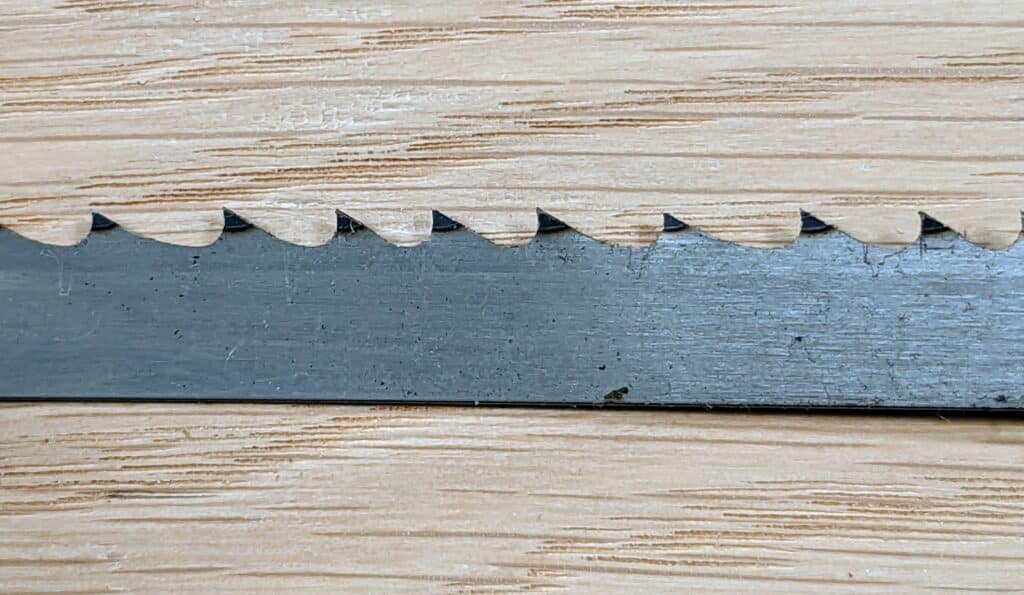
The bandsaw blade I recommend is their Super Tuff Premium Band Saw Blade 1/2″ x 3/4 Vari-tooth pattern. It gives an excellent cutting speed with quality. I have cut wood 7-8″ deep in every wood with no problem.
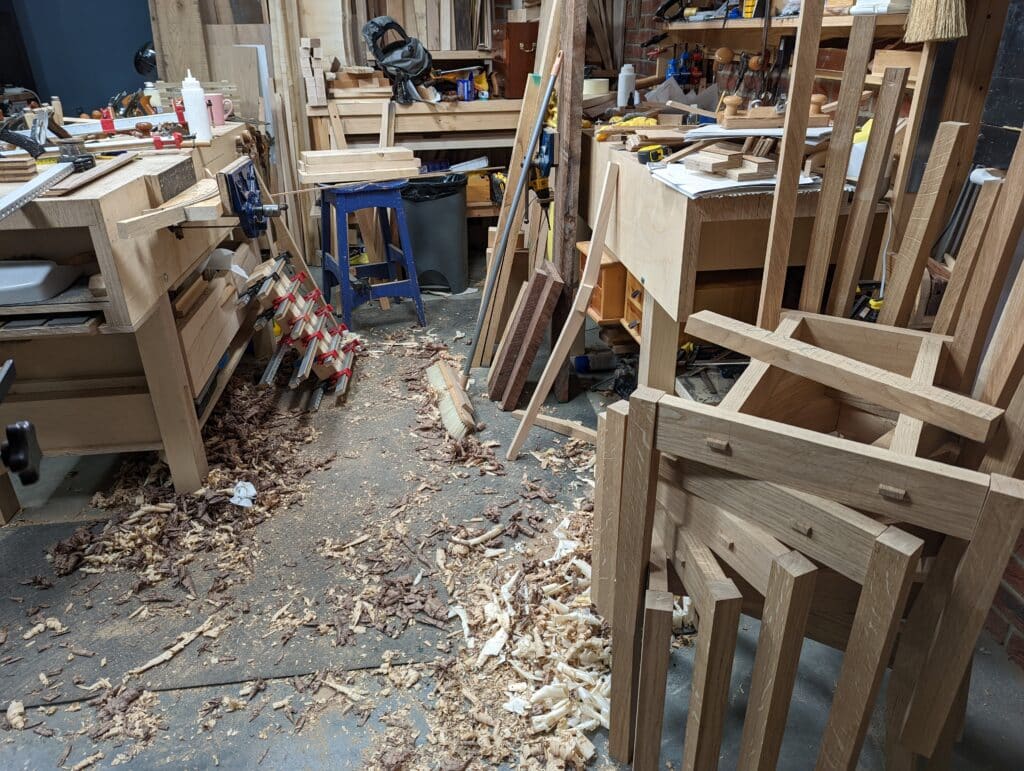


Hi Paul, I like your comparison with spending time in gyms. For the last few weeks I’ve spend many hours with a shovel a pickaxe and a wheelbarrow taming the wilderness in the back of our garden to be able to plant fruits and veggies and to finally set up my bandsaw (that’s been sitting unused and wrapped in foil for two years in the garden because there was no space inside) under a small canopy (that is yet to be built) digging out many old stumps including pine, maple, Robinia and a few smaller hazels and others all grown over by ivy and steering a few hundred wheelbarrow loads onto a steadily growing hill. What an exercise! The neighbors of course knew that it could be done with excavators and all kind of equipment much quicker but then I couldn’t listen to the birds singing, I wouldn’t learn more about the properties of the different species with maple roots snapping due to their brittleness whereas I enjoyed tying knots in the pine roots etc etc. Yes, it’s donkey work but it’s calm and outside. Have a good week, Paul!
I know that feeling of stacking up parts ready for the next step. Love it! And sweeping up the results of good, manual labor – there’s few things that comes close to it, in my mind.
Also good to see that Mr. Paul Sellers indeed do use a select few other tools than the usual suspects. No luxury items, I think. A 16” band saw is no small investment, but I would not be without mine. If I need to remove 10mm off of a piece, I saw it off. The offcut can be used in small projects or laminations, not become an offering to the god of dust collector bins via the thicknesser – or a big heap of curly shavings which I can find little to no use for.
And as you pointed out: a few swipes with the hand plane, and the surface is left pristine.
“Work smart, not hard” indeed. Even though following that advice can and will (and should?) involve a moist forehead from time to time..
dear paul,
off topic apologies, but I wonder if one day…perhaps for a relaxing break from furniture making 🙂 … you might consider doing a blog or masterclass video on making a sash window and frame?
I can see from prior passing comments you’ve made (eg about water drip channels) that you are knowledgeable about this, and I suspect there are a few tricks to doing this ‘properly’.
there are some seriously scary videos on youtube for making windows/ frames via machines with no guards, but decent window making – particularly with hand tools – seems a dying or dead art unfortunately (with not much information i could fine), and it would be nice to see how it can be done well.
otherwise if you know of a book or other resource about window making that would be much appreciated.
a window and frame seems like it might also be something that would be fantastic for building skills (??), and would be handy to light a darkened shed, let alone a living room!
kind rgds
paul
Hello – take a look at the book “Door making and Window making”. This has been republished by Lost Art Press. Also available in pdf form.
It should be exactly what you are looking for. Tom W
I have already considered this as the vintage book, copied and some reprint versions are indeed outdated and behind our modern-day times with so many new developments that have radically improved how such pieces function with regards to water- and draught-proofing, etc. They also leave much out in terms of practicalities, terminology, quality of drawings and drawing detail so on. Also, many of the doors and sliding sash and sash windows shown in some editions would/could never be made today as many would never comply or be accepted for different reasons. I’d like to see/write such a book to deliver what would actually offer all that is necessary for people to make their own joinery to door and window sizes that can be customised to their particular applications. Something like we are currently doing with furniture making and woodworking via sellershome.com
paul – i’d buy that book in a heart beat!
and tom – thankyou for the suggestion, will have a look.
and i’d buy the DVD too…!
Paul
I have tried my hand at making window sashes in the past and they can be a bit challenging. Having the correct moulding plane & cutters etc is important but it can be done by studying the way windows were made pre industrial revolution.
I had a shop that I built that needed a few windows. So I kept my eye out for old window sash along the side of the road and going to salvage shops. I did find a fine sash with divided lite 4 wide x 3 high. With a little elbow grease and a good dose of linseed oil, the sash was back to “good as new” condition! Then I built the frame, added modern weather stripping and it turned into a very functional hopper window ( tilts in & hinges from the bottom). The window added nice character to my shop.
John B
Thanks Paul.
I am not a minimalist tool worker. I have been thinking of getting a bevel up plane just to have and try one and understand what it does well and when I might want to use it. Where do you find find a bevel up plane useful? I know it’s not essential.
I was fortunate that my grandma (born 1904 and lived to age 97) lived next door to us growing up. After my grandfather passed away, I moved into her home (if there is much a move since she was next door) to keep an eye on her and help her. With the exception of my grad school, I lived with her till my early 30s. The dilemma I faced when I was 30 and had moved back home was that she want to still do my laundry. At first, I would sneak and it without her knowing. She would then say “what, you don’t love me?” I eventually realized two things, these “chores” were practical exercise and kept her young. Eventually we reached a compromise where she did some but not too much that was excessive work for her. I’ve been reading about “blue zones” in the world; areas of where there are high clusters of healthy long lived individuals. One of the things I have read is that their exercise is built into their daily life as hobbies or chores. You are spot on with your approach.
Paul has done a YouTube video on this which may be useful to you…
https://youtu.be/10RPOPBTwZA
Thanks for the video. I will have to go through older posts by Paul. Tying to see if there is a special situation where having a bevel up plane is advantageous. I know i don’t one. Just want to know if I get one where it might come in handy for that once a month use.
Hi Paul,
Being just a bit older than you, I am amazed at how many things we agree upon–especially the value of real work as a means to stay healthy. Who needs a gym membership when you live on a small farm? Despite the fact that I have been in the healthcare business for many years, I have derived so much pleasure during my life, just by learning how to use my body efficiently, whether in various athletic endeavors, or in survival activities because I did not always have the money to hire things done.
People forget that the US transcontinental railroad was built just one tie at a time, and thus when the phone company and local excavators said my hill was too steep to install a phone line (before wireless, of course), I simply applied myself with shovel and pick and dug the 1/4 mile trench myself. It took a whole summer, but I have to say nothing beats the satisfaction of honest work. 🙂
Bravo!
Mary Jensen
Paul,
Please excuse my ignorance, but, I’m confused on the recommended blade size of 1/2″ x 3/4″.
I know you have to have the right length, then width, but I’m confused on the 2 numbers you reference.
Thanks,
Patrick
1/2″ is the width, the 3/4 is the variable tooth distance as it is not fixed as in most bandsaws. so it is three to four teeth to the inch hence 3/4
Thanks Paul I kind of figured that’s what you meant thanks for clarifying I actually contacted tough saws but looks like their site is down till the 1st of April but as long as I know you meant 1/2 in by 3/4 skip tooth variable tooth pattern I know there’s a couple other manufacturers that make quality blades that I can order from here in the US.
Hi Patrick,
I presume Paul is referring to a 1/2″ wide blade with variable tpi ranging from 3 to 4 tpi.
Thanks Francois, that’s what my gut told me but I figured it couldn’t hurt to ask…… As you can see Palm beat ya to it…..lol
It’s too bad that lengthy explanations need to be made for choosing muscle over electricity. Whether it be metal , wood, or yard work the right tool for the right job is determined by many factors, including exertion, but, very often, the final decision comes down to simplicity and peace of mind.
Along with puttering about, I am an avid canoeist and hiker. Just as the swish of a paddle and drumming of a partridge are priceless sounds never experienced when travelling by motor driven craft, the sounds of shop crafts and household chores, augmented by backyard birds and greetings from passing neighbours, are soothing, not jarring, and are Welcome parts part of the task rather than a bothersome annoyance.
Good evening Paul,
Interesting timing for your post, as I was curious for your take on this. A different blogger I read wrote a post a week or 2 ago about the repetitive use injuries he’s beginning to feel after long stretches of hand work. Particularly elbows, back, and fingers (I think he meant from having his hands wrapped around chisels and gripping for long periods). I don’t know his exact age but I believe he’d be in roughly his mid-50’s at this point.
My question for you…do you notice these things after a long day of hand planing and joint cutting? What would be your advice for preventing these injuries or at least minimizing the chances of it happening? One opinion of mine is that this author recommends a bench height that i consider very low. I originally built mine based on his recommendation and I had to lift it to make my work more comfortable.
Thank you as always for your insights and beautiful work.
Mike Thompson
Mike, I have zero aching in my body even though for most days I do not sit down or stop working much at my workbench as I have done now for 57 years to date and that is six days a week with four to five of these days being over ten hours a day physically working. It is now 8 pm and I started at 7 am this morning with a three-quarter-hour business meeting from 10 am until 10.40 am. I took a half-hour lunch break and no breaks in between. Most of today has been planing, sawing, clamping and so on. I can chop mortises all day long with no hand issues in terms of pain. I put this down to consistent handwork throughout my woodworking life working a six-day week full time and the bench height that should if anything be too high rather than too low. I speak from experience thriving rather than bold statements taken from a book written by an authority may be a few years in the saddle. I think every authority I have read on has been dead wrong about bench heights for working men using a bench in the every day of life. I’ve blagged about this until I am blue in the face and have trained 6,500 woodworkers using the average man height of 5’10” and a workbench height matching this and using it as a baseline of 38″. Better to start too high and cut the legs down incrementally in 1/2″ increments than to work at a bench that is too low. A low bench height will be a guarantee of long-term and irreparable back pain.
57 years, 6 days a week. Therein lies the secret, if there is one! The strength, flexibility and resilience built when young and maintained through consistent use makes us more able to dodge some of the aches and pains of ageing. As an amateur woodworker who is well used to various physical work, I know that overworking a muscle set that hasn’t been used for a while might let me know about it for a day or two. But that’s OK – it just reminds me those muscles are there. At 73 I still very much enjoy physical work, but I’ve learned to know my limits for the daily round. But I know that I’ll ache a bit if I engage in an activity I haven’t done for a while, using muscles that haven’t been worked much. An example I learned years ago was using a wheelbarrow all day to shift earth. The following day I had no upper body problems, but my calf muscles were killing me! I hadn’t expected to feel it there, but it’s pretty obvious when you consider the physics involved.
I’m Paul’s age, and have no problems. I think posture and work height are super important, even for things like gripping chisels. Fingers connect to hands that connect to forearms, elbows, etc. LIne it all up and let your body operate as it was made to work.
I’m 5ft 10in, and built Paul’s bench at 38in. I have used lower heights, and the result is stiffness and fatigue.
Mostly piling on: posture at the bench, tool sharpness and hammer selection.
Any soreness I had was during the construction of Paul’s bench, for which I used a 32″ tall bench bought at Harbor Freight (these days I use it as an assembly table). I’m 185cm (6’1″) and I built Paul’s bench to stand 39″ tall.
Tool sharpness: if the tools aren’t sharp, they will require more force to control, more force to have them bite, and so on. My understanding of the meaning of sharpness improved over time – what I used to call sharp in the early days is now when I decide I need to sharpen up.
Hammer selection: I bought and used for a few years a 12 oz hammer from Lowes. It worked fine, didn’t want to spend the money for something heavier when there really wasn’t anything wrong with it. After one of its faces eventually cracked, I decided to use it as a (flimsy) justification to just buy the Thorex Paul recommended. The difference between the 18oz and the 12oz is simply impressive. All I have to do is lift the hammer, and let it fall in a controlled fashion – very little effort from my arm, so the muscles and joints are much more comfortable.
I have made similar points about getting exercise in my little shop. It’s definitely a benefit. Challenging too to remember to take a breather when you’re tired enough that your form goes off (just like being at the gym).
With all those boards planed and looking great, are you concerned you’ll have to plane them again when you’re ready to use them?
New week! Life!
And another happy and healthy 75 years for you, sir!
For those not trained as Paul,
– make a 20′ walk or bicycle ride to warm up your body before start;
– alternate operations, don’t do the same operation a whole day long;
– work with sensitivity, let the tool do the work;
– take breaks and drink enough water;
– make stretching exercises when you stop working, like one would do after sport.
That’s great advice. Not just for woodworking……for any physical activity.
I’d add a couple of things:
– Pay attention to your body. If something starts to tingle or hurt, stop and see if your posture, position or something else is non-optimal.
– When you do take a break, take that opportunity to sharpen your edge tools.
Thanks for these Sylvain.
Paul, you did a nice series on bandsaws some time back, but I don’t think you got into issues like drift and other such refinements that can be so important to resawing. Maybe that is something to return to? Maybe I’ve overlooked this info. If so, please let me know where to look.